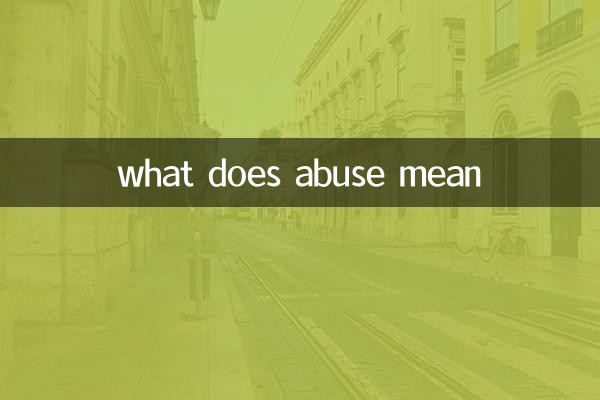what does abuse mean
In recent years, social discussions about "abuse" have increased, especially abuse incidents involving children, animals, the elderly and other vulnerable groups, which have frequently attracted public attention. So, what exactly does abuse mean? This article will give you a comprehensive analysis of this social phenomenon from multiple perspectives such as definition, type, legal definition, and recent hot cases.
1. Definition of abuse

Cruelty is defined as the infliction of harm, suffering or deprivation of basic rights to another person or animal through physical, psychological, emotional or financial means. Abuse is usually persistent, intentional, and unequal in power. The abuser often uses his or her dominant position to control or harm the victim.
2. Main types of abuse
| type | definition | Common symptoms |
|---|---|---|
| physical abuse | causing bodily harm by violent means | Beating, pinching, scalding, etc. |
| psychological abuse | Causing emotional harm through words or actions | Threats, humiliation, isolation, etc. |
| sexual abuse | Forcing or inducing sexual behavior | Sexual assault, sexual exploitation, etc. |
| financial abuse | Deprive or control economic resources | Restrictions on property use, forced labor, etc. |
| ignore | Failure to fulfill basic duty of care | No food, medical care, etc. provided |
3. Analysis of hot-spot abuse incidents in the past 10 days
The following are the hot topics related to abuse that have been hotly debated across the Internet recently:
| event | Involving groups | heat index |
|---|---|---|
| Incident of corporal punishment of children by a kindergarten teacher | child | ★★★★★ |
| Video of cat abuse in pet shop exposed | animal | ★★★★☆ |
| Case of elders in nursing homes being abused by caregivers | elderly | ★★★★☆ |
| Sentence pronounced in domestic violence death case | women | ★★★☆☆ |
| Internet violence leads to teenage suicide | teenager | ★★★☆☆ |
4. Legal Consequences of Abuse
Our country’s laws have clear penalties for abuse:
| Legal terms | Scope of application | Punishment measures |
|---|---|---|
| Article 260 of the Criminal Code | abuse by family members | Fixed-term imprisonment of not more than 2 years or criminal detention |
| Article 260-1 of the Criminal Law | Abuse of guardians and caregivers | Fixed-term imprisonment of not more than 3 years or criminal detention |
| "Anti-Domestic Violence Law" | domestic violence | Personal safety protection order, etc. |
| "Minor Protection Law" | abuse of minors | Severe punishment |
5. How to prevent and respond to abuse
1.Raise awareness:Understand the various manifestations of abuse and enhance recognition skills.
2.Report promptly:If you discover any abuse, you should immediately report it to the public security organs or relevant departments.
3.Social support:Provide psychological counseling, legal aid and other support services to victims.
4.Educational propaganda:Popularize anti-abuse knowledge through public service advertisements, community activities and other means.
5.Improve legislation:Promote the improvement of relevant laws and regulations and increase the punishment of abusers.
6. Conclusion
Abuse is a serious social problem that not only causes physical and mental trauma to the victims, but also destroys social harmony and stability. By understanding the definition, types, and legal consequences of abuse, each of us can become an anti-abuse participant and advocate. The recent frequent incidents of abuse once again remind us that protecting vulnerable groups and opposing all forms of abuse requires the joint efforts of the entire society.
If you or someone close to you is experiencing abuse, remember: you are not alone and the law and society are there to support and protect you. Stand up bravely, let the abuser receive the punishment he deserves, and let justice be done.

check the details

check the details